Small, economical cars may soon be in vogue again – for the same reasons they used to be in vogue. Money’s tight – and things cost more.
Gas, especially.
Thus, buying a car that doesn’t use much – and that doesn’t cost much – has appeal, again.
A car like the Mini Cooper.
The Mini Cooper is the smallest new car available in the U.S. – as well as one of the most affordable, with a base price of $23,400 for the hardtop coupe (which seats five). A slightly larger version with four doors is also available, with a starting price of $24,400.
This one is still two feet shorter, end to end, than a compact-sized car like the current Honda Civic.
But it’s big on charm – and easy on gas.
What’s New
The Mini hasn’t changed much since 2014, but that’s not a bad thing if you like what the Mini is – and what it resurrected. That being the original ‘60s Mini concept of lots of fun in a small package that’s surprisingly big on the inside. 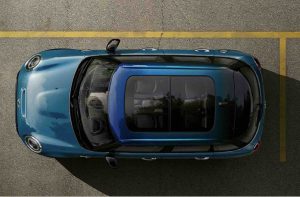
In addition to that sameness, there’s also some newness – in the form of a new-design front grille, a standard digital main gauge cluster and new multi-color (and multi-tone) paint combinations that enable the buyer to almost custom-order their Mini’s outward appearance.
What’s Good
Saves you money on gas – without costing you fun.
One of the few new cars you can buy that still comes standard with a manual transmission.
Two and four-door bodystyles – and both have more room inside than many much larger cars.
What’s Not So Good
Small (11.6 gallon) gas tank makes the Mini seem thirstier than it is.
Small – relative to the size of just about everything else. You may feel like a mouse scurrying around among elephants.
Curb weight (2,712 lbs. for the two-door) is more than it ought to be for a car this small.
The two and four-door Minis are available with your pick of three different engines, all of them driving the front wheels only. Standard equipment is a turbocharged 1.5 liter three cylinder engine (one of the smallest engines available in a new car) that makes 134 horsepower and 162 ft.-lbs. of torque. It’s paired up with a standard six speed manual transmission or – optionally – a seven speed automatic.
Interestingly, there is almost no difference in gas mileage regardless of transmission choice. With the manual, the Mini rates 27 city, 37 highway; with the seven speed automatic, it’s virtually the same: 28 city, 37 highway. Either way, these are big numbers, a function of the car – and its engine – being small.
They’d be better, though, if the car were less heavy. 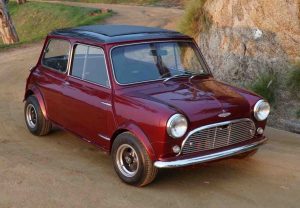
The two-door Cooper weighs in at a surprisingly hefty 2,712 lbs. – which is only slightly less heavy than the significantly bigger Honda Civic sedan mentioned earlier, which weighs 2,877 lbs. It manages 31 city and 40 on the highway – about the same mileage as the much smaller (and smaller-engined) but just-about-as-heavy Mini.
But why is the Mini as heavy as it is – for its size?
Probably because of its size.
If that sounds paradoxical, it’s only because you may not appreciate the effect of government “safety” regulations on curb weight. Specifically those pertaining to crash-testing. In order for a tiny car like the Mini – which has almost no car ahead of its front wheels or behind its rear wheels – to pass these tests, additional structure is needed behind those abbreviated overhangs and these add the weight you can’t see from the outside. It makes the Mini more crumple-resistant if you run into something – or if something runs into you – but it also makes it less fuel-efficient than it could otherwise have been. 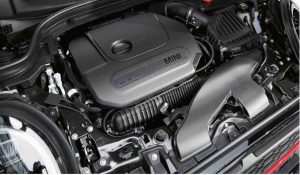
It is hard to know exactly how much more efficient it could have been without somehow lopping off the 1,173 pounds or so of curb weight that separate the modern Mini from the original Mini of the ‘60s – which weighed just 1,539 lbs. – but it is probable it’d be more efficient than the Civic sedan, so probably close to 50 MPG on the highway.
And that’d be a really big inducement to buy such a small car – even if the risk of crumpling up in the event something ran into it were higher. “Safety” is a value. But it’s not the only value. Especially when it’s a hypothetical vs. an actual value. You may never run into anything – or have someone run into you. But you will pay for every drop of gas the car uses. 
End sidebar.
A larger – stronger – turbocharged 2.0 liter engine is available in the S versions of the Mini. This one makes 189 horsepower and 206 ft.-lbs. of torque (at just 1,350 RPM). The same transmission choices are available. It also uses a bit more gas – but only a bit: 23 city, 33 highway.
The big bite – as regards both engines – is their wanting of premium unleaded, which adds bigly into the cost of driving a Mini. The good news is that you don’t have to use premium; it won’t hurt the engine to fill the tank with less costly regular. But it will hurt power output/performance – as the Mini’s computer will dial back the turbo boost if it senses lower-octane fuel. 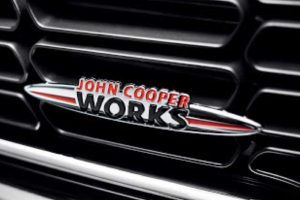
If this seems paradoxical, it’s probably because you’re unaware that Mini is actually a BMW – a premium brand. And the Mini uses engines designed by BMW and shared with BMW models. People who buy BMWs are by definition affluent people and such people are less worried about the cost of fuel than people who aren’t.
The other good news is that performance is good. Even with the standard 1.5 liter engine, the Mini can get to 60 in just over 7 seconds. With the stronger 2.0 liter engine, it’s just over 6 seconds. And if you want a really speedy Mini, there’s the John Cooper Works (JCW) version of the Mini, which is powered by a tuned and tweaked version of the 2.0 liter engine that makes 228 horsepower – enabling it to get to 60 in less than six seconds.
Driving a small car can be big fun.
In a small car, you can exploit those small gaps in traffic that larger cars can’t. You can slip past the left lane hog who is almost pacing the car to his right, but left just enough space for a small car to dart through the opening – and get around both. You can also park in spots larger cars can’t; some that only motorcycles can. And when you park in your garage, there is still space in your garage.
The Mini also connects you to the drive as closely as a car can without being a motorcycle. You’re close to the road, even more so than a bike, because of how low the Mini sits. Ahead of you is the road – because there’s very little hood.
But there is also not much wheelbase – the distance between the front and rear axle centerlines. Just 98.2 inches. The wheelbase of a compact sedan such as the Honda Civic mentioned earlier is 107.7 inches, nearly a foot longer.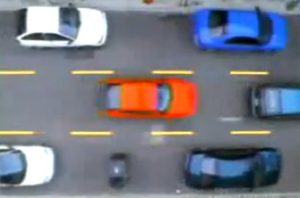
What does it mean?
The Mini is quicker to react to directional changes – because the rear wheels follow so closely behind the front wheels. The car also has an extremely tight turning circle (just 35.4 feet – about a foot tighter than the Civic’s). It is a highly maneuverable little skateboard, ideal for busy traffic and perfect for having fun in it. But it’s also more apt to come around on you in the curves, if you don’t keep your foot on the gas. The rear end is close – and light. When the weight shifts – as when lifting off the gas in the middle of a curve you went into too fast – it can swap places with the front end.
So be sure to keep on the gas in those curves, if you take them fast.
The ride is also skateboard-like, as you’d expect. This isn’t a deficit; it just comes along for the ride. 
And there is that shifter – if you want it – as opposed to a gear selector.
Ten – five – years ago, being able to shift for yourself would not have been especially remarkable. You could get a manual in sedans like the Honda Accord and Toyota Camry, both automatic-only now. Even the Corvette is automatic-only now. Yes, the automatic’s shifts are quicker and more consistent. You never miss a shift when the selector is in Drive. But the action of shifting gears – and more than just that, of operating the clutch in syncopation with your shifting – is an intangible reward that cannot be quantified by cold numbers alone.
The manual in the Mini makes it a more engaging car to drive – because you literally are, in a way that you cannot be when all the engagement you’ve got is to put it in Drive and push down on the gas.
The Mini is . . . mini. Whether two or four doors, it is so abbreviated in length you look at it and think it might fit in your pocket. And – naturally – you then wonder what (if anything) will fit inside it.
It turns out to be a lot more than you might think.
The two-door version is just 152.2 inches long, end to end. Yet it has 41.4 inches of legroom for the driver and front seat passenger as well as 34 cubic feet of space if you make use of the available space by folding the back seats forward. This is a lot of space for a car this small. To convey some sense of how much space, consider that a Civic sedan-sized car only has 14.8 cubic feet of total cargo space.
Even with its back seats in use, the Mini’s still got 8.7 cubic feet of space behind them – which is about twice as much space for stuff as in the Mazda Miata, a two-seater sports car that is also a couple of inches longer than the Mini.
The two-door Mini’s back seats – which it has – are a little tight, having just 30.8 inches of legroom. But this is more legroom – again – than in many other much larger, allegedly four-seater two-door sporty cars like the Chevy Camaro, for instance (which only has about 26 inches of rearseat legroom) and the Ford Mustang, too (which has 29 inches and is three feet longer).
The Mini is also taller.
Not higher.
It only stands 55.7 inches off the pavement. But its roof doesn’t slant and its windshield is more upright – and that allows for more headroom in this little car than in many much larger cars: 40.3 inches up front and a functionally viable 36.9 inches for the back-seaters.
To convey some sense of that, there are only 34.8 inches of headroom in the backseat of a Mustang. There’s even less (33.5 inches) in the back of a Camaro.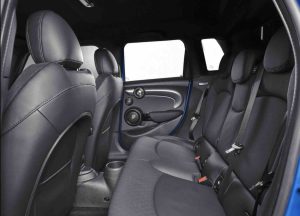
Duck and cover.
The long and short being that the Mini is more practical than you might think at first glance. This includes having the option to choose the four door, which increases both access as well as backseat legroom, which increases to 32.3 inches.
But while these numbers – and choices – are important, they are not what makes the Mini.
Style does.
There is no other car that resembles it – except another Mini. And each Mini can be customized with factory and dealer options such as to make each one more individual than other cars, as well as other Minis.
The Rest
The new/standard digital dash is very modern but the toggle switch controls for many functions are happily retro – and uncommon. This way of turning things off and on is intuitive and satisfying in a way that tapping/swiping isn’t.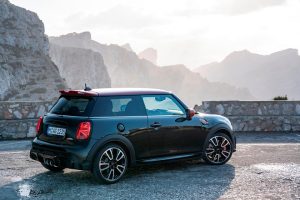
One thing that’s missing – due to its Mini-ness – is a spare tire. It would take up too much space. So – instead – there’s a tire-repair/inflator kit. This is fine – and works – provided you haven’t got a sidewall tear. If you do, then you’re stuck!
The Bottom Line
Small is beautiful, especially when it’s also practical – and affordable. Both to buy and to drive.
. . .
Got a question about cars, bikes or anything else? Click on the “ask Eric” link and send ’em in! Or email me directly at EPeters952@yahoo.com if the @!** “ask Eric” button doesn’t work!
If you like what you’ve found here please consider supporting EPautos.
We depend on you to keep the wheels turning!
Our donate button is here.
If you prefer not to use PayPal, our mailing address is:
EPautos
721 Hummingbird Lane SE
Copper Hill, VA 24079
PS: Get an EPautos magnet or sticker or coaster in return for a $20 or more one-time donation or a $10 or more monthly recurring donation. (Please be sure to tell us you want a magnet or sticker or coaster – and also, provide an address, so we know where to mail the thing!)
My eBook about car buying (new and used) is also available for your favorite price – free! Click here. If that fails, email me at EPeters952@yahoo.com and I will send you a copy directly!





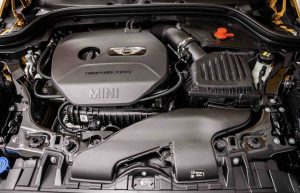










Wife had a 2019 Mini Countryman John Cooper Werks Edition. It had the 2.0 turbo. Had 65k miles and was certified through mini. She loved that car and it could get almost 40 mpgs if you were nice to it. Sounded great and was pretty peppy. Unfortunately it was plagued by problems and it was to much for me to work on. Had a coolant leak that wasnt going to be covered under warranty. I know it sounds crazy but they were going to charge me 2k to fix it because it was buried under the motor. After fighting back and forth and getting really angry I finally got them to finally cover it. Later the brakes needed to be replaced. You need some stupid tool to release the servo on the rear brakes so you cant do it yourself unless you have this tool. Did the front brakes myself. Of course theyre expensive ceramic performance ones. Then the last straw was the battery. A two year old battery went out on us. Can you just go to walmart and plop one in and be done? No of course not, apparently its programmed and wont work right unless you get it programmed. Never heard of such a thing. Had to jump start it, run off the alternator and drive it an hour and a half away to get charged 500$ for a replacement. We traded it off that day. Wife misses it but we had 3 major problems in 6 months on a factory certified mini. Not worth the fuel mileage savings.
Belated question for you, Mr. Peters: does the new Mini have the electronic-nanny driver-“assist” functions that so many other this-year vehicles have?
I wasn’t considering the Mini, due to the engines all being turbocharged and the cub weight being so high. But I am curious about e-nanny. Is that just a given these days?
Thanks!
Hi James,
Yes – unfortunately. After all, the Mini is a BMW – and BMW (like other luxury car brands) is all-in when it comes “safety.” But – the good news – these “features” can be disabled/turned off. At least, for now…
Anonymous is right on. Ever seen an original 911 parked next to a new Smart? The Porsche looks dinky in comparison. The new Mini should really be called a Midi.
Hi Doug
All the new cars are overweight whales,
the new 911 is 3399 lb, the best 911 was the 1973 Porsche 911 Carrera RS 2.7 it weighed 2000 lb. the new Mini is 2712 lb, fat compared to the old 911….
For people who like driver’s cars they say there was one close to perfect car
1973 Porsche 911 Carrera RS 2.7
The RS is the ultimate 911 and is special because of the way it drives. Sure it is rare and expensive, but it is the driving experience that elevates the 2.7 RS to icon status. The sound, the acceleration, the free-revving engine, the feel through the steering and chassis, the cornering poise, the wieldy dimensions, the look and smell of the thing. It is engaging, fun and it just sucks you in. Sure, 210 bhp and 188 lb/ft of torque doesn’t sound like much today but remember the RS Sport weighs only 900kg (2000 lb.) so that power is more than enough.
It is genuinely fast, in both outright acceleration and point-to-point pace. It hits 0-60mph in 4.9 seconds and tops out at 155 mph. It is small and narrow with deep windows and slim pillars, so there’s road to spare and you can see it all, it feels faster and the speed is more encompassing than in today’s models.
You can do 100 mph in a McLaren 720S and not even blink an eye. Doing 60 mph in the 2.7 RS it feels like 100 mph and you are enthralled by the experience. Too many modern cars of great pace slip up here; the 911 RS 2.7 is more usable and enjoyable than any of them.
It’s such an easy car to drive fast too. The rear engine and the plentiful high-revs torque simply make this a car steerable on the throttle. The sound is unmistakable – a deep bass driven yowl overlapped with fast-paced tapping and the rush of accelerated air. The higher the RPM, the better it sounds.
The Carrera RS earned a reputation as the ultimate driver’s 911. Even today, superlatives like thrust, pointability and adhesion are levelled at the Carrera RS driving experience. It’s raw, unadulterated air-cooled 911 at its most focused. The signature flat-six wail, as it passes through the 4500rpm mark on its way to the redline is one of the more iconic soundtracks and, with such low weight and respectable power, it’s still quick by today’s standards
the 911 Carrera RS 2.7 won world championship races including Targa Florio and the 24 Hours of Daytona where it beat all the prototypes.
The Porsche Carrera RSR had proven its worth in its first race at the Daytona 24 hr. and would dominate GT racing for several years and become one of the most successful GT cars ever. The 2.8-litre engine would quickly be replaced by a more powerful 3.0-litre unit. The RSR would win Daytona again outright in 1975 and 1977 as well as Sebring in 1973, 1976 and 1977.
None of the new cars including the supercars/hypercars can give you the same experience they are all over weight.
The quickest cars in the world usually weigh 2000 lb or less, a modern 3000 lb to 4500 lb supercar/hypercar will never be as fast, you can’t overcome that much extra weight.
To overcome the weight they add huge hp, this makes the car unstable so they control it with, stabilize it with AI, computers, they drive the car you don’t. These aren’t driver’s cars you are just along for the ride….
The new EV’s are worse they are all far over weight and they lack any emotion, you can’t hear, smell or feel these cars.
One auction result: 1973 Porsche 911 Carrera 2.7 RS Lightweight 9113600883 – sold for $1,402,500.00…..when a car is that good, people will pay for it…..
https://www.supercars.net/blog/1973-porsche-911-carrera-rs-2-7-lightweight/
The best driver’s cars/track cars are the ultralights like the Super 7 which weigh about 1200. lb.
Overengineered by BMW. Plastic everything. Maintenance and repair nightmare. Overweight and overpriced for a compact.
Get a Versa or Mirage new or a Fit or Yaris used if you want to save money on gas and repairs. Leave the german rube goldberg mobiles for idiot snobs. Just look at resale values to see how bag VAG mobiles really are.
At least this one didn’t have a tranny hiccup like the last one Eric reviewed…
My 1995 Mk 3 Golf GTI looks small beside a Mini now, it is also lighter 2300 lb. with the Audi 1.8 Lt. 20 valve turbo stage 2 engine swap….240 HP it is also quicker…and fully analog, 5 speed, no airbags, PW, ABS, traction control, it does have an engine computer and OBD2…..
government: use less gas
also government: we will make it impossible to use less gas
the need for premium gas makes a real hit against buying this car as an economy option.
i do agree the mini is one of the most interesting looking cars